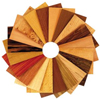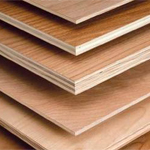With its pretty grain patterns and wood like appearance, veneered furniture is often mistaken for solid wood. Yet you could not be more wrong. There is actually a tremendous difference between the two.
So what exactly is meant by veneered wood?
 |
A veneer is created from a very thin layer of timber. In some cases, the veneer can be almost paper thin. Hardwood veneers are as thin as 1/64 of an inch, with most veneers are around 3mm thick which look like typing paper, it is almost transparent, and can never be sanded, refinished or significantly touched up if damaged. Modern furniture is often made from manufactured wood products such as MDF or plywood that has been covered with a thin veneer of natural timber. This layer has been glued in layers to make it light weight and strong. Variations on the veneer is common and depends on where the tree is from and the climate conditions in that environment both affect the veneer’s structure and colour. All kinds of wood are used to create the veneer layer. Sometimes expensive, rare woods are used as a veneer on top of a cheaper wood. Typical base woods that are combined with veneers include Pine, Oak, Ash, Beech, Cherry, Larch, Maple, American Walnut, Teak, Fir and Wenge. The resultant material can only be used for flat surfaces such as the tops, sides and bases of furniture. Trying to shape or cut veneered wood will damage the veneer. Furniture made out of veneered wood possesses the outward appearance of wood complete with the grain and smooth finish but it’s not actually solid wood. |
Long history
 |
Using veneered wood to make furniture does have a long history. The Ancient Egyptians were the first to pioneer this technique. They used it extensively to create furniture and sarcophagi. Over the centuries, veneering techniques have also led to the creation of very beautiful marquetry designs in which furniture has been inlaid with a variety of light and dark woods to form pictures or geometrical images. |
Ideal furniture
 |
Veneered wood combined with a solid wood base makes ideal furniture as it gives strength and beauty. This is the most sustainable and environmentally friendly way of enjoying beautiful rare woods such as ebony within the home. Decospan are one of the top companies creating high quality veneers using woods like Hemlock, Iroko, Lacewood and Zebrano to be made into furniture. |
Caring for veneered furniture
 |
|
How to recognise veneered furniture
 |
|
|
Advantages of veneered furniture
|
Disadvantages
|
Such disadvantages can be overcome by buying quality furniture as any problems are due to poor manufacturing and workmanship.
Overview
 |
Veneered wood is very eco-friendly as it allows more economical use of timber, especially unusual or rare woods. Every scrap of veneer is used. Unlike solid wood, veneers cannot be carved or ornamented. Instead attention focuses on the grain and the sheer beauty of the veneer. Often veneers can provide a wider range of colours and textures than might otherwise be available. Solid wood combined with a pretty veneer can create an eye catching piece of furniture possessing style and timeless elegance. Ultimately it is up to you to decide just what you prefer and what would suit your home best. |
Veneered wood provides a wonderful way to obtain special woods and very special furniture for your home. Extremely eco-friendly, it allows you to enjoy the sheer beauty and grain of unusual, rare woods in a vast range of shades. Solid wood combined with a pretty veneer creates eye catching furniture possessing style, elegance and character. It is a winning combination.


